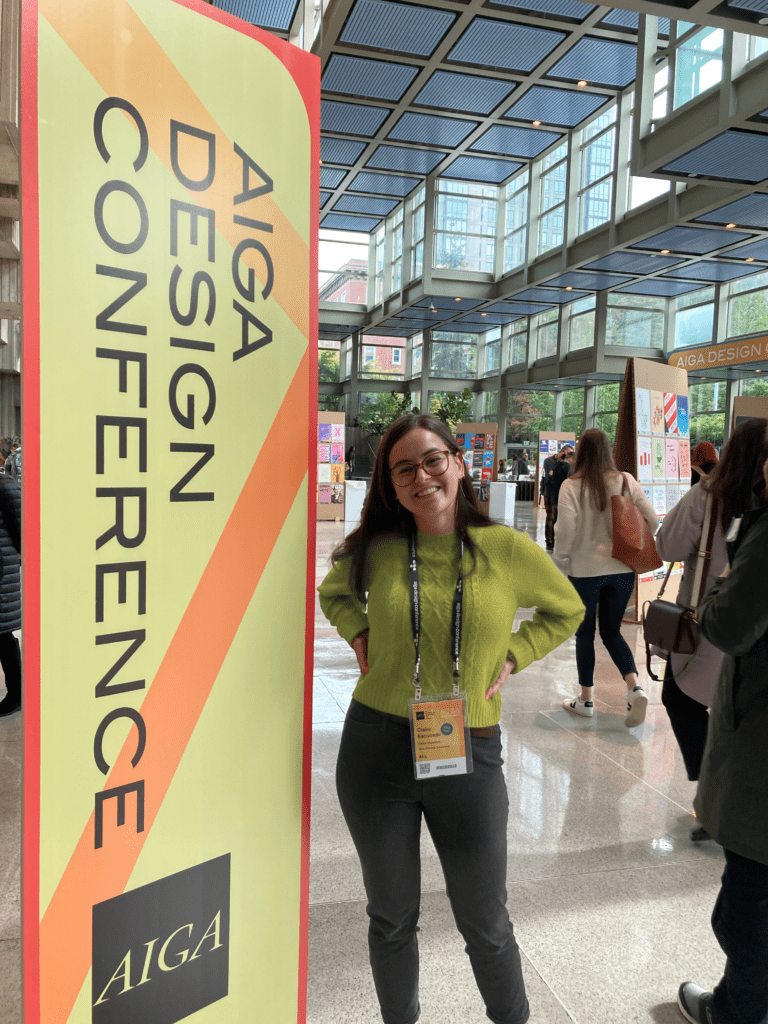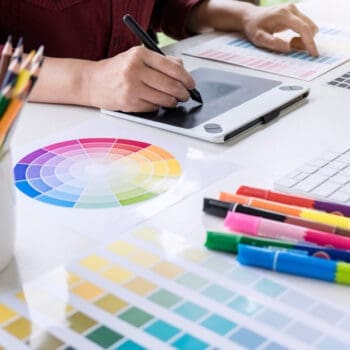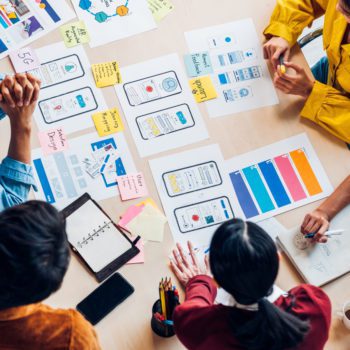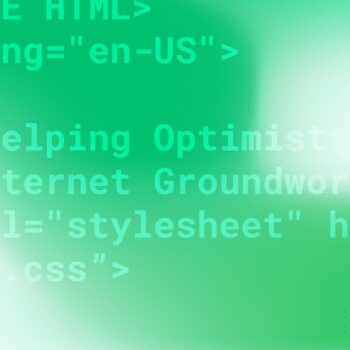AIGA Design Conference 2022: Love, Care, and Kindness + Diversity, Equity, and Inclusion in the Design Industry

Last month, I was happy to represent Online Optimism at the AIGA Design Conference in Seattle, Washington! The first in-person AIGA conference since 2019, themed “Re-Connect,” was an incredible opportunity to meet other creatives, hear new perspectives, and see some excellent work. Plus, I saw some of my design heroes in person, which made the whole thing worth it alone.
Despite the wide range of topics at this year’s AIGA conference, from practical design ethics to creating typefaces for television to new ways of thinking around design education, a few common focus areas tied everything together. Diversity, equity, and inclusion was a huge theme, as was the development of an ethic of kindness, care, and love in the design industry. I couldn’t believe how many times I heard the word “love” at a professional conference—but it excited me for the industry’s future!
Here are a few of the most impactful sessions I attended, with particular regard to these themes:
A Fireside Chat with Audrey Liu
I was inspired by Audrey Liu, VP and Head of Design at Lyft, who spoke to us about her role as both a design team leader and a mother. As a woman in leadership, she shared that she often works outside of what’s expected from a “traditional” leader, but this enables her to find her leadership voice, appreciate the varying work styles of her team members, and give them more grace as people. She also talked about motherhood as an opportunity, among so many other things, to let go of the things she can’t control and focus on what she can, which has become a skill she takes to work. This talk happened early in the conference, and I was so energized by hearing a successful design leader at a major tech company talk about demonstrating care for her team and taking her full maternity leave!

The Black Experience in Design: Identity Expression and Reflection with Anne Berry, Jennifer Rittner, and Kelly Walters
Three of the author/editors of The Black Experience in Design—Anne Berry, Jennifer Rittner, and Kelly Walters—discussed the creation of this book, a collection of essays on the Black experience in design. It was so interesting to hear about their process as they sought to document and, in some cases, reframe the past; navigate the present; and look toward the future with a global, intergenerational perspective. They talked at length about how important it was to include a wide diversity of voices and points of tension and disagreement, as well as to find writers from underrepresented spaces and even create new areas outside of what’s been defined.
They also shared that a big part of putting the book together was building community across physical space, especially from isolated areas, since most of the book’s production took place in 2020 and 2021. As a big fan of art and design history, I was so excited to hear about this book that I bought it at the conference bookstore—I’ve only just started reading it, but so far, it has been well worth the work of cramming a 600-page book into my already-full suitcase.
A Fireside Chat with Mauro Porcini
I really enjoyed hearing from Mauro Porcini, SVP & Chief Design Officer at PepsiCo, who believes design innovation should be an expression of love, and that we need to make space for love in the design industry and business in general. He spoke about how he’s worked to redefine his company’s culture, centering love and investing in kindness, which he said has increased trust and productivity on his team. It was inspiring, again, to hear someone so successful be so passionate about prioritizing kindness and love in our industry!
I am a Cynical Designer, and You Can Be One Too! With Shasti O’Leary Soudant
This talk was one of the most inspiring and vulnerable talks of the conference, and I loved it. Shasti O’Leary Soudant, an artist and Visiting Assistant Professor at University at Buffalo, spoke about what she’s learned about her responsibility as a designer throughout her career. She shared with us the progression of her cynicism about working for capitalist gain when she didn’t believe in that as an end, which was interesting. She also talked about her realization of the absolute need for self-awareness when she’s deciding what’s getting made and about how she’s found balance in doing art and design work for reasonable financial or commercial gain and the good of the work and its outcomes. One thing that stuck with me was that she said good design should have no victims—and that we, as designers, are responsible for considering all the possible outcomes of our work to make this so.

Design Ethics and Action Symposium with Cennydd Bowles, Katherine Zhou, Supriya Kulkarni, and Mollie Ruskin
This symposium on design ethics continued several of the themes I heard from other speakers, especially the responsibility of designers for how our work shapes opportunity and ability.
Cennydd Bowles talked about design as an opportunity to “give care in absentia,” to care for people you might not know or be present to. This positions designers to be champions of ethics and consider how best to care for people. He reframed the widespread mindset of user-centered design, asserting that design work should also consider non-users, society at large, the environment, and non-human actors and how they might be affected. Follow Cennydd on LinkedIn.
Katherine Zhou went deeper into what irresponsible design can look like, referencing examples like deceptive design patterns or closed-off UI options, and spoke against the prioritization of growth as a singular goal of design work. Instead, she suggested defining different metrics to measure success and performance, like care for people and positive environmental outcomes, in evaluating how effective design work is. Follow Katherine on LinkedIn.
Supriya Kulkarni advocated introducing industry standards for ethics that all design work would be held to, like compulsory accessibility standards, and referenced the practice of value-sensitive design as a good guide for this. Follow Supriya on LinkedIn.
Mollie Ruskin spoke about the importance of creating safe, inclusive design workplaces where designers can ask ethical questions and make changes when needed. She shared about the company culture she’s worked to develop at Trestle Collaborative, where they commit themselves to justice and equity in their work and ensure the whole team is treated like “whole humans.” Follow Mollie on LinkedIn.
I loved hearing from this group about how they’ve incorporated design ethics into their work and workplaces. A lot they shared didn’t make it into my summary above, so if you’re interested in design ethics, these are all great people to follow!
The Pipeline HBCU for Career Education in the Design Industry with D’Wayne Edwards
D’Wayne Edwards of the Pensole Lewis College of Business and Design talked to us about why it was important to him to open the only current HBCU in the US with a focus on design. He shared that he wanted to create a career education program that focused on building a creative community and had extremely high-quality instruction from Black faculty. D’Wayne also emphasized the importance of continuously questioning educational institutions and changing them when needed, and how this can apply to companies and the industry at large, too.
One thing that stuck out to me, too, was that D’Wayne said he only accepts donations or partnerships with companies if they have real, authentic reasons for why they want to work with Lewis College. I loved hearing about how committed he is to uphold the highest standards of DEI and authenticity, and I’m so excited to see what some of the new designers coming out of Lewis College will accomplish.
Several other speakers and sessions referenced love, kindness, and care, as well as diversity, equity, and inclusion, as crucial components of designing physical community spaces, designing in support of democracy, and building company and industry cultures. I’m so glad I got to attend and hear all these perspectives, and so thankful to all the speakers who shared them!

P.S. Some of the cool things I saw
- The University of Colorado at Boulder’s Media Archaeology Lab, a digital media lab devoted to hardware, software, and media of the past, presented by libi rose striegl.
- Piotr Szyhalski’s COVID-19: Labor Camp Report series, a collection of daily illustrations made throughout 2020. This project first existed as an Instagram series and now exists as a book.
- David Reinfurt’s many projects, including O-R-G and Dot Dot Dot (I love how under-designed this website is), and his assertion that you have to let things come to an end to keep your work fresh.
- All of the weird, wacky, and wonderful work made by DesignInquiry residents, as presented by Margo Halverson.
- The imaginative, immersive design fiction work by Julian Bleecker and his team at the Near Future Laboratory. It was refreshing to see an imagined future through an optimistic lens!
- Whoosh, a new public transportation system that combines cable and rail networks, presented by John Schaefer of Holmes Solutions.
- Kelli Anderson’s work, which uses paper and other physical materials to create delightful interactive technologies and other projects.
At Online Optimism, true to our company value to Always Optimize, we’re always working to make our work and our company culture the best they can be. I’ve enjoyed thinking through implementing my takeaways from the AIGA Design Conference at work, and I’m excited for the next time I attend!
Are you looking for design inspiration? Read some of our other design-related blog posts below!



